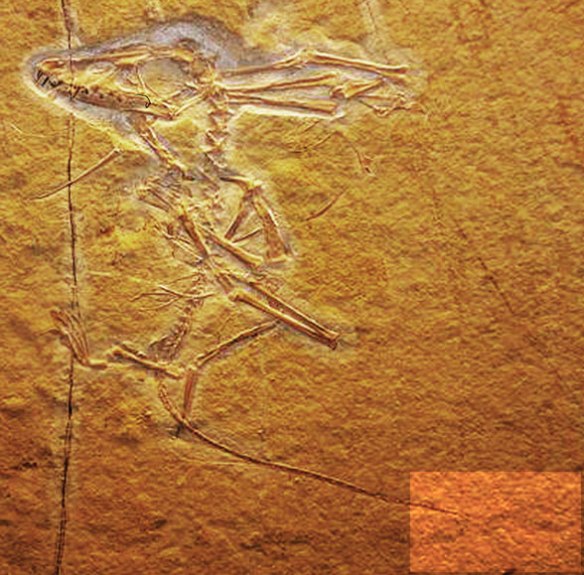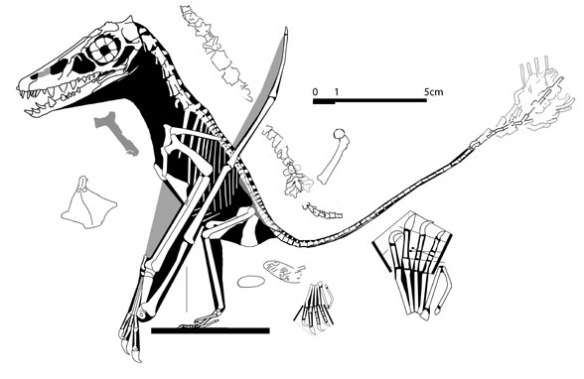| Online: | |
| Visits: | |
| Stories: |
Updating a little Scaphognathus
When I find better data, I use it.
Case in point, the Maxberg specimen of Scaphognathus (n110 in the Wellnhofer 1975 catalog, no. 992 in the solnhofen-fossilienatlas.de catalog). My earlier data came from Wellnhofer (1991). The earlier image can still be seen by googling “maxberg specimen Scaphognathus“.
The Maxberg specimen is smaller than the holotype, but that doesn’t make it a juvenile, as Bennett (2004, 2014) proposes. Think of it as a sparrow compared to a blue jay in size relative to the larger holotype of Scaphognathus (n109, Fig. 1).
In phylogenetic analysis, the Maxberg specimen descends from the larger holotype (n109). It is similar in size, but not identical in morphology, to the SMNS 59395 specimen of Scaphognathus. The Maxberg specimen is larger than proximal descendant taxa seen here (Fig. 1). So, more than Darwinopterus, Rhamphodactylus or the Painten pterosaur, the Maxberg specimen is a transitional taxon, bridging part of the gap between the long-tails rhamphs and the short-tailed pterodacs.
I found the Maxberg specimen on the Solnhofen commercial fossil site - solnhofen-fossilienatlas.de catalog – which we looked at earlier here and here.

Figure 2. The Maxberg specimen of Scaphognathus as found at the Solnhofen commercial fossil website.
The photo (Fig. 1) is rather low in contrast, so the first step is to boost it (Fig. 3).

Figure 3. Same Scaphognathus specimen, image contrast boosted. Tip of the tail has a vane-like shape.
Next step: color tracing (Fig. 4).

Figure 3. Tracing of the Maxberg specimen of Scaphognathus. Two odd little ellipses are traced here, both able to pass through the reconstructed pelvis exit. These could be anything. They need to be looked at more closely. Note the ilia are back shifted relative to the sacral vertebrae. Long, tail stiffening zygopophyses are visible.
Reconstruction brings it all together (Fig. 4). So much easier to deal with when not looking like a roadkill. Not sure why more pterosaur workers don’t do this.

Figure 4. The Maxberg specimen of Scaphognathus reconstructed. Even with the updates, the nesting does not shift. There’s something interesting going on with the nares, splitting into a primary and secondary naris. Like all Scaphognathus, this specimen has tiny feet. This is the first or maybe second stage in the reduction of the tail as all descendant taxa (Fig. 1) have an even more gracile tail.
The new image updates the old one in several subtle ways, none of which are enough to shift the nesting. There are two oval structures in the matrix. And they happen to be just the right size to be pterosaur eggs. Someone will have to take a closer look at this to determine if the bumps are pterosaurian or not. There is a symmetrical disturbance in the matrix at the tail tip that appears to represent a vane, though distinct from the more distinct tail vanes of Campylognathoides and Rhamphorhynchus.
Phylogenetically the Maxberg specimen is basal to cycnorhamphids and ornithocheirids.
References
Bennett SC 2004. New information on the pterosaur Scaphognathus crassirostris and the pterosaurian cervical series. Journal of Vertebrate Paleontology, 24: 38A
Bennett SC 2014. A new specimen of the pterosaur Scaphognathus crassirostris, with comments on constraint of cervical vertebrae number in pterosaurs. Neues Jahrbuch für Geologie und Paläontologie, Abhandlungen, 271(3): 327-348.
Wellnhofer P 1975a. Teil I. Die Rhamphorhynchoidea (Pterosauria) der Oberjura-Plattenkalke Süddeutschlands. Allgemeine Skelettmorphologie. Paleontographica A 148: 1-33. 1975b. Teil II. Systematische Beschreibung. Paleontographica A 148: 132-186. 1975c. Teil III. Paläokolgie und Stammesgeschichte. Palaeontographica 149: 1-30.
Wellnhoffer P 1991. The Illustrated Encyclopedia of Pterosaurs. London: Salamander. 192 pp.
wiki/Scaphognathus
Source: https://pterosaurheresies.wordpress.com/2014/03/26/updating-a-little-scaphognathus/





